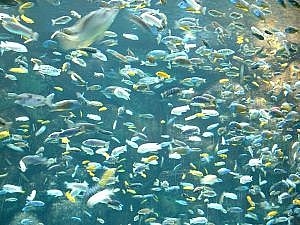
Scientific Name(s): Xiphophorus mac-ulatus (Platy); Xiphophorus hellerii (Swordtail)
 Ease of Breeding: Easy
 Introduction: These hardy, colorful fish were among the first tropical fish kept in aquaria, and remain very popular. Platys were first bred in captivity in Italy in the 1860s.
 Sex Differences: The anal fin of mature males has been modified into a tubeÂlike structure called a gonopodium. Male swordtails also have long, pointed projections on their tails.
 Water Conditions: Not critical.
 Equipment: No special equipment required for breeding, but parents eat their young, so provide lots of hiding places, or separate them from their parents after birth.
 Conditioning and Triggers: Platys and Swordtails seem to reproduce under almost any conditions. However, conditioning them separately with live food, such as white worms, mosquito larvae, and brine shrimp, for a week or two before spawning may proÂduce a better yield of fry.
 Spawning: A male courts a female by fanning his fins and posturing in front of her, then latches his gonopodium to her vent to transfer sperm. Gestation is about 28 days. Shortly before giving birth, she'll develop a gravid spot; she also may hide or become quieter than usual. At this point, move her to a breeding trap to protect the fry, or place her in a birthing tank; if you remove her shortly after she gives birth, you can raise the fry in the same tank.
 Brood Size: Anywhere from a few to 100 or more depending on the condition and size of the female.
 Fry Care: If rearing fry in the main tank, provide them with plenty of plants or even floatÂing plastic "fry hideouts" (available at pet shops) so they can escape hungry tankmates. Better yet, transfer them to a bare-bottomed grow-out tank equipped with a sponge filÂter and a heater. Feed at least four times daily for best growth; fry are large enough to eat regular flake food crushed into a powder, but also appreciate fresh or frozen baby brine shrimp, microworms, and/or commercial fry food. Fry are sensitive to water-qualÂity problems; for optimal health and growth, change 10 to 25 percent of the water daily.
 Special Notes: These species readily crossbreed, so keep them in separate tanks to avoid hybridization.
 Species with Similar Breeding Habits: Mosquitofish (Gambusia affinis).
 How to Feed an Oscar Fish
How to Feed an Oscar Fish
How to Feed
How to Feed an Oscar Fish
How to Feed an Oscar Fish
How to Feed
 Turtles As Pets
You may not realize just how
Turtles As Pets
You may not realize just how
 What Causes Fish to Die in a Pond?
What Causes Fish to Die in a Pond?
Wha
What Causes Fish to Die in a Pond?
What Causes Fish to Die in a Pond?
Wha
 Cloudy Aquarium Water
How to Get Keep My Aquarium Water Clear
Cloudy Aquarium Water
How to Get Keep My Aquarium Water Clear
 What Fish Can Live in Brackish Water
What Fish Can Live in Brackish Water
W
What Fish Can Live in Brackish Water
What Fish Can Live in Brackish Water
W
Copyright © 2005-2016 Pet Information All Rights Reserved
Contact us: www162date@outlook.com